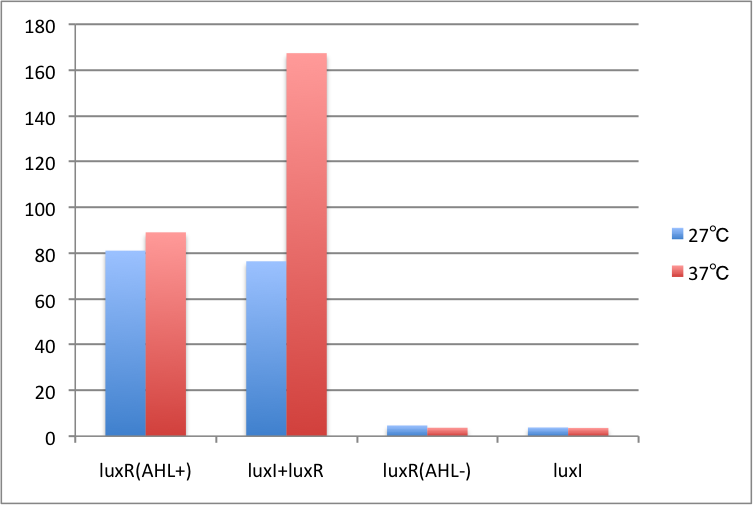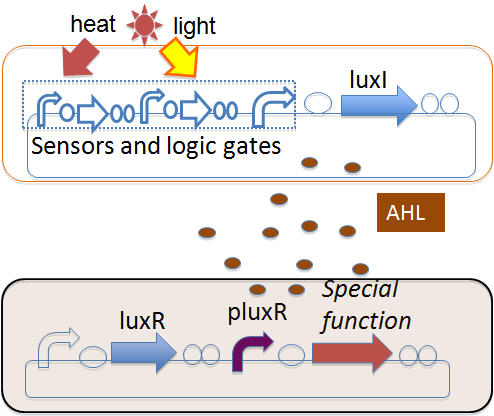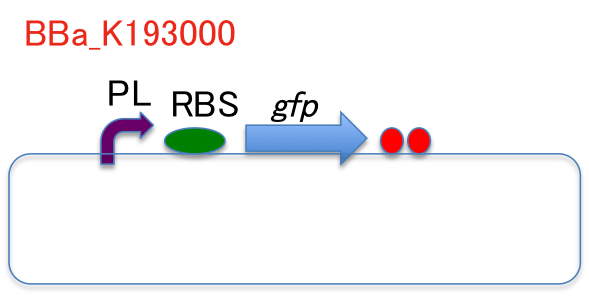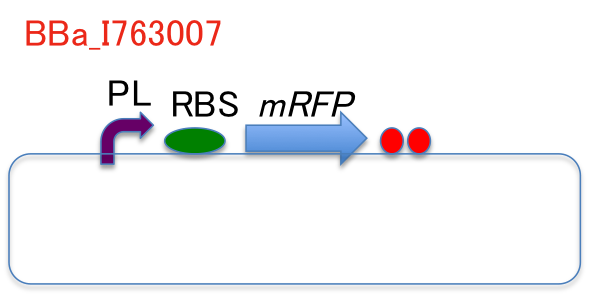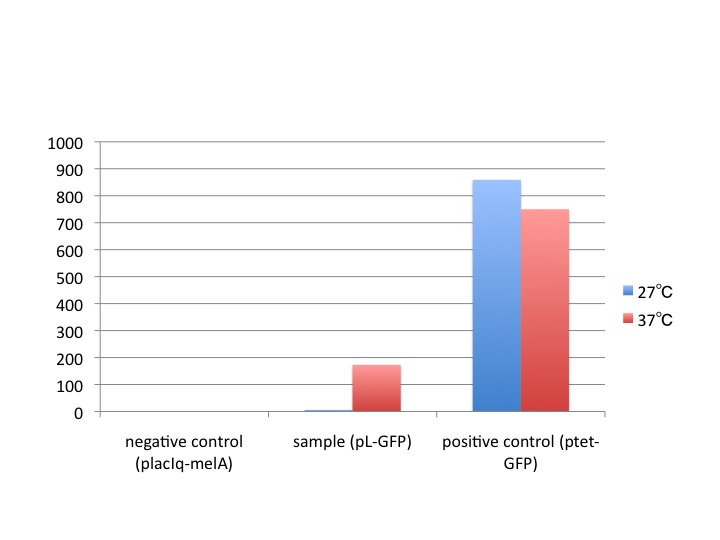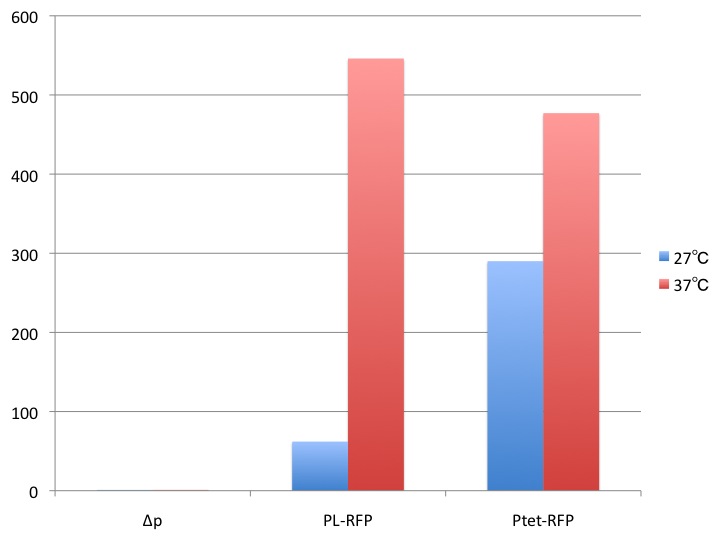Team:Tokyo Tech/Consortium
From 2009.igem.org
(→Protocol-Assay-) |
(→Result) |
||
| (123 intermediate revisions not shown) | |||
| Line 1: | Line 1: | ||
{{Template:Tokyo_Tech_Menu}} | {{Template:Tokyo_Tech_Menu}} | ||
| + | |||
==Achievement== | ==Achievement== | ||
| + | [[Image:Tokyo tech consortium11.png|400px|thumb|Difference in GFP expression observed dependent on temperature]] | ||
| + | We confirmed the temperature-regulated function of lux signaling system. | ||
| - | + | *luxR+luxI; strain N4830 transformed with luxR expressing plasmid and luxI expressing plasmid | |
| + | *luxR(AHL+),(AHL-); positive control; strain N4830 transformed only with luxR expressing plasmid | ||
| + | *luxI; strain N4830 transformed with luxI expressing plasmid | ||
==Introduction~Why do we need Microbial consortium?~== | ==Introduction~Why do we need Microbial consortium?~== | ||
| Line 11: | Line 16: | ||
Microbial consortium is a group of different species of microorganisms that are interacting with each other. For instance, there are predator-prey interactions, communications and so on. | Microbial consortium is a group of different species of microorganisms that are interacting with each other. For instance, there are predator-prey interactions, communications and so on. | ||
| - | ===Why do we need Microbial consortium for | + | ===Why do we need Microbial consortium for terraforming of Mars?=== |
| - | In Mars, as described above | + | In Mars, [http://partsregistry.org/Part:BBa_K193000 as described above], there are much carbon dioxide and carbonate. However there is little amount of organic matter. Heterotrophic microorganism like ''E.coli'' cannot survive on its own. |
| - | + | ||
| - | ,there are much carbon dioxide and carbonate. However there is little amount of organic matter. Heterotrophic microorganism like ''E.coli'' cannot survive on its own. | + | |
That's why autotrophic microorganisms are needed for the production of organic compounds in early stage of terra-forming. | That's why autotrophic microorganisms are needed for the production of organic compounds in early stage of terra-forming. | ||
| - | In order to survive harsh conditions on Mars, bacteria should be adapted to environmental change. Therefore, | + | In order to survive harsh conditions on Mars, bacteria should be adapted to environmental change. Therefore, introducing various sensing elements to bacteria can be one solution, such as temperature sensor, light sensor, pH sensor and so on. |
It is difficult to introduce intricate genetic circuitry to autotrophic microorganism(cyanobacteria,iron-oxidizing bacteria...etc), on the other hand intricate genetic circuitry can be introduced to ''E.coli'' easily. | It is difficult to introduce intricate genetic circuitry to autotrophic microorganism(cyanobacteria,iron-oxidizing bacteria...etc), on the other hand intricate genetic circuitry can be introduced to ''E.coli'' easily. | ||
| Line 27: | Line 30: | ||
===A simple model of microbial consortium=== | ===A simple model of microbial consortium=== | ||
[[Image:Tokyo_Tech_Circuit01.png|200px|thumb|Simple model of microbial consortium]] | [[Image:Tokyo_Tech_Circuit01.png|200px|thumb|Simple model of microbial consortium]] | ||
| + | |||
| + | We considered interaction between two species as a microbial consortium model.<br\> | ||
| + | We use Master ''E.coli'' and specialized bacteria like iron-oxidizing bacteria.<br\> | ||
| + | Standard bacteria have signaling devices regulated by sensors and logic gates. | ||
| + | Meanwhile, specialized bacteria have additional function that is activated by signals. | ||
| + | |||
| + | ===Temperature sensing using lux signaling=== | ||
We constructed plasmid that contains temperature-regulated luxI as a key signaling device. | We constructed plasmid that contains temperature-regulated luxI as a key signaling device. | ||
| - | This system uses a temperature-sensitive | + | This system uses a temperature-sensitive CI repressor to regulate the lambda promoter. ''E.coli'' N4830 strain expresses temperature-sensitive CI protein constitutively. |
| - | |||
| - | BBa_K193001( | + | [http://partsregistry.org/Part:BBa_K193001 BBa_K193001] (CI repressible LuxI generator) |
| - | BBa_J54140( | + | <br\>[http://partsregistry.org/Part:BBa_J54140 BBa_J54140] (LuxR generator) |
| + | <br\> | ||
| + | <br\>[[Image:Tokyo tech K193001.png|200px]][[Image:Tokyo J54140.png|267px]] | ||
| - | |||
| - | |||
| - | + | We applied luxI signaling to temperature-regulated system. We introduced luxI signaling device and GFP reporter to ''E.coli'' N4830 strain. In this system, if ''E.coli'' produces AHL under conditions of high temperature, ''E.coli'' expresses GFP. | |
| - | + | ||
==Materials and Methods== | ==Materials and Methods== | ||
| - | === | + | ===Reporter Assay=== |
| - | + | Each strain was grown overnight(~12 hours ) at 37℃ and shaken in 3ml LB. Then two sets of fresh culture were made by diluting aliquots of the overnight culture with LB medium to OD600 = 0.1. One set of the culture is incubated at 37℃ while the other set is incubated at 27℃ for 6 hrs. | |
| - | + | After 6 hours, we took 1 ml of each culture to 2 ml tube, and centrifuged for 1 min at 9000 rpm. | |
| - | + | ||
| - | After 6 hours, | + | |
We discarded the supernatant with a pipette. We dissolved the pellet at the bottom of the tube in PBS to dilute samples to OD=0.8. | We discarded the supernatant with a pipette. We dissolved the pellet at the bottom of the tube in PBS to dilute samples to OD=0.8. | ||
| - | We took 200 μl of the washed culture to 96-well plate and measure its fluorescence intensity by Fluorescent Image Analyzer(FLA) and Fluorescence Activated Cell Sorting(FACS). | + | We took 200 μl of the washed culture to 96-well plate and measure its fluorescence intensity by Fluorescent Image Analyzer (FLA) and Fluorescence Activated Cell Sorting (FACS). |
The measured fluorescence intensity was normalized by subtracting the background fluorescence intensity of PBS. The corrected value was normalized to culture volume and OD600 and expressed in fluorescence per (ml x OD600). | The measured fluorescence intensity was normalized by subtracting the background fluorescence intensity of PBS. The corrected value was normalized to culture volume and OD600 and expressed in fluorescence per (ml x OD600). | ||
| - | === | + | ===experiment1 BBa_K193000 (GFP reporter regulated by CI)=== |
| - | *The target strain was N4830 transformed BBa_K193000( | + | *The target strain was N4830 transformed [http://partsregistry.org/Part:BBa_K193000 BBa_K193000] (GFP reporter regulated by CI). |
| - | [ | + | [[Image:Tokyo tech K193000.png|200px]] |
| + | *Positive control strain was N4830 transformed with [http://partsregistry.org/Part:BBa_K121010 BBa_K121010] (Ptet-GFP), which expresses GFP constitutively. | ||
| + | *Negative control strain was N4830 transformed with [http://partsregistry.org/Part:BBa_K193601 BBa_K193601] (PLacIq-RBS-melA), which does not express GFP. | ||
| - | |||
| - | |||
| - | |||
| - | === | + | ===experiment2 BBa_I763007(mRFP reporter regulated by CI)=== |
| - | *The target strain was N4830 transformed with BBa_I763007( | + | *The target strain was N4830 transformed with [http://partsregistry.org/Part:BBa_I763007 BBa_I763007] (mRFP reporter regulated by CI). |
| - | [ | + | [[Image:BBa I763007.png|200px]] |
| + | *Positive control strain was N4830 transformed with [http://partsregistry.org/Part:BBa_I13521 BBa_I13521] (Ptet-mRFP), which expresses mRFP constitutively. | ||
| + | *Negative control strain was N4830 transformed with [http://partsregistry.org/Part:BBa_I13504 BBa_I13504] (promoterless-gfp), which does not express mRFP. | ||
| - | |||
| - | |||
| - | |||
| - | http://partsregistry.org/Part: | + | ===experiment3 BBa_K193001 (CI repressible LuxI generator)=== |
| + | *The target strain was N4830 transformed with [http://partsregistry.org/Part:BBa_K193001 BBa_K193001] (CI repressible LuxI generator) and [http://partsregistry.org/Part:BBa_J54140 BBa_J54140] (LuxR generator). | ||
| + | [[Image:Tokyo tech K193001.png|200px]][[Image:Tokyo J54140.png|267px]] | ||
| - | + | *Positive control strain was N4830 transformed with [http://partsregistry.org/Part:BBa_J54140 BBa_J54140], which expresses GFP. (AHL+) | |
| - | * | + | *Negative control-1 strain was N4830 transformed with [http://partsregistry.org/Part:BBa_J54140 BBa_J54140], which leaky expresses GFP. (AHL-) |
| - | [ | + | *Negative control-2 strain was N4830 transformed with [http://partsregistry.org/Part:BBa_K193001 BBa_K193001], which does not express GFP. |
| - | + | ==Result== | |
| - | + | ||
| - | + | ||
| - | + | ||
| - | + | ||
| - | + | ||
| - | + | ||
| - | + | ===experiment1 BBa_K193000=== | |
| + | [[Image:Tokyo_tech PL-GFP.jpg|300px|right]] | ||
| - | == | + | negative control Ptet GFP; the strain N4830 transformed with Ptet(constitutive promoter)-GFP/RFP plasmid |
| + | |||
| + | PL GFP; the strain N4830 transformed with PL(cI-repressible promoter)-GFP/RFP plasmid | ||
| + | |||
| + | positive control placIq-melA ; the strain N4830 transformed with placIq-melA plasmid | ||
| + | |||
| + | |||
| + | The culture of the strain with pL-GFP at 37℃ showed about 30 folds higher fluorescence intensity than that at 27℃, While the culture of the strain with ptet-GFP at 37℃ and at 27℃ showed almost the same fluorescence intensity. | ||
| + | This result indicates that pL is regulated by temperature-sensitive cI chromosomally expressed by N4830. | ||
| + | |||
| + | |||
| + | ===experiment2 BBa_I763007)=== | ||
| + | [[Image:Tokyo_tech PL-mRFP.jpg|300px|right]] | ||
| + | |||
| + | Ptet mRFP; the strain N4830 transformed with Ptet(constitutive promoter)-GFP/RFP plasmid | ||
| + | |||
| + | PL mRFP; the strain N4830 transformed with PL(cI-repressible promoter)-GFP/RFP plasmid | ||
| + | |||
| + | ⊿p ; the strain N4830 transformed with mRFP plasmid (not equipped with any promoter) | ||
| + | |||
| + | |||
| + | The culture of the strain with pL-mRFP at 37℃ showed about 10 folds higher fluorescence intensity than that at 27℃. Though the culture of the strain with ptet-GFP at 37℃ showed about 1.5 fold higher fluorescence intensity than that at 27℃, the increasing rate differs greatly between the former and the latter. | ||
| + | This result indicates that pL is regulated by temperature-sensitive cI chromosomally expressed by N4830. | ||
| + | |||
| + | |||
| + | ===experiment3 BBa_K193001=== | ||
| + | [[Image:Tokyo tech consortium11.png|300px|right|thumb|Difference in GFP expression observed dependent on temperature]] | ||
| + | |||
| + | luxR(AHL+),(AHL-); strain N4830 transformed only with luxR expressing plasmid | ||
| + | |||
| + | luxR+luxI; strain N4830 transformed with luxR expressing plasmid and luxI expressing plasmid | ||
| + | |||
| + | luxI; strain N4830 transformed with luxI expressing plasmid | ||
| + | |||
| + | |||
| + | |||
| + | In the strain with luxR, GFP expression was observed dependent on the presence of AHL. In the strain with both of luxR and luxI, difference in GFP expression was observed (at 27℃ and at 37℃.) dependent on temperature. The culture(strain with luxI and luxR) grown at 37℃ showed 2.2 fold higher fluorescence intensity than that grown at 27℃. This result indicates that the pL promoter and luxI presumably worked properly in the luxI expressing plasmid we made. | ||
| + | |||
| + | This experiment was conducted by Shinya Tahara and Tomohiro Koizumi(student member). | ||
==Discussion== | ==Discussion== | ||
| - | |||
| - | |||
| - | |||
| - | + | ||
| + | We successfully constructed pL-GFP plasmid, pL-mRFP plasmid, luxI expressing plasmid, and luxR expressing plasmid and measured the activity of these parts quantitatively. In this time,we introduced both of luxI expressing plasmid and luxR expressing plasmid into the same strain, however in the future we would like to introduce them into different strain and moreover, in different bacteria such as oxidizing bacteria. Then the consortium we aimed will be implemented. | ||
| + | |||
| + | Furthermore, we expect multiple sensor and logic gates to be introduced in addition to cI-dependent temperature sensitive sensor. | ||
==Reference== | ==Reference== | ||
| - | *Katie Brenner, Lingchong You and HFrances H. Arnord, Engineering microbial consortia: a new frontier in synthetic biology, '' | + | *Katie Brenner, Lingchong You and HFrances H. Arnord, Engineering microbial consortia: a new frontier in synthetic biology, ''Trends in Biotechnology'', 2008 |
Latest revision as of 03:56, 22 October 2009
| Main | Team | Terraforming | Experiments | [http://partsregistry.org/cgi/partsdb/pgroup.cgi?pgroup=iGEM2009&group=Tokyo_Tech Parts] | Safety |
Contents |
Achievement
We confirmed the temperature-regulated function of lux signaling system.
- luxR+luxI; strain N4830 transformed with luxR expressing plasmid and luxI expressing plasmid
- luxR(AHL+),(AHL-); positive control; strain N4830 transformed only with luxR expressing plasmid
- luxI; strain N4830 transformed with luxI expressing plasmid
Introduction~Why do we need Microbial consortium?~
What’s Microbial consortium?
Microbial consortium is a group of different species of microorganisms that are interacting with each other. For instance, there are predator-prey interactions, communications and so on.
Why do we need Microbial consortium for terraforming of Mars?
In Mars, [http://partsregistry.org/Part:BBa_K193000 as described above], there are much carbon dioxide and carbonate. However there is little amount of organic matter. Heterotrophic microorganism like E.coli cannot survive on its own. That's why autotrophic microorganisms are needed for the production of organic compounds in early stage of terra-forming.
In order to survive harsh conditions on Mars, bacteria should be adapted to environmental change. Therefore, introducing various sensing elements to bacteria can be one solution, such as temperature sensor, light sensor, pH sensor and so on. It is difficult to introduce intricate genetic circuitry to autotrophic microorganism(cyanobacteria,iron-oxidizing bacteria...etc), on the other hand intricate genetic circuitry can be introduced to E.coli easily.
Our approach is the following.
Establishing consortium can give benefit both to E.coli and to autotrophic microorganism(cyanobacteria,iron-oxidizing bacteria...etc).
A simple model of microbial consortium
We considered interaction between two species as a microbial consortium model.
We use Master E.coli and specialized bacteria like iron-oxidizing bacteria.
Standard bacteria have signaling devices regulated by sensors and logic gates.
Meanwhile, specialized bacteria have additional function that is activated by signals.
Temperature sensing using lux signaling
We constructed plasmid that contains temperature-regulated luxI as a key signaling device.
This system uses a temperature-sensitive CI repressor to regulate the lambda promoter. E.coli N4830 strain expresses temperature-sensitive CI protein constitutively.
[http://partsregistry.org/Part:BBa_K193001 BBa_K193001] (CI repressible LuxI generator)
[http://partsregistry.org/Part:BBa_J54140 BBa_J54140] (LuxR generator)
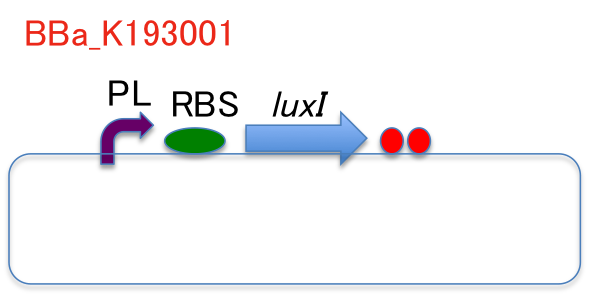
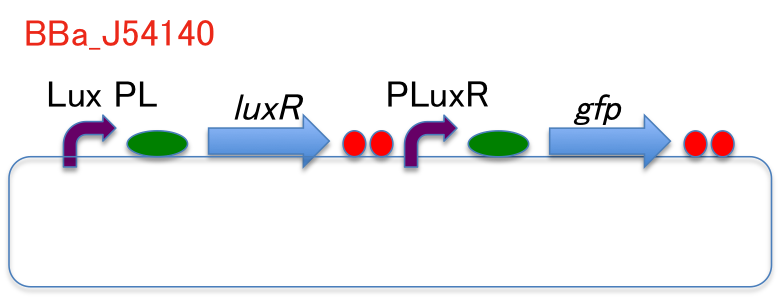
We applied luxI signaling to temperature-regulated system. We introduced luxI signaling device and GFP reporter to E.coli N4830 strain. In this system, if E.coli produces AHL under conditions of high temperature, E.coli expresses GFP.
Materials and Methods
Reporter Assay
Each strain was grown overnight(~12 hours ) at 37℃ and shaken in 3ml LB. Then two sets of fresh culture were made by diluting aliquots of the overnight culture with LB medium to OD600 = 0.1. One set of the culture is incubated at 37℃ while the other set is incubated at 27℃ for 6 hrs. After 6 hours, we took 1 ml of each culture to 2 ml tube, and centrifuged for 1 min at 9000 rpm. We discarded the supernatant with a pipette. We dissolved the pellet at the bottom of the tube in PBS to dilute samples to OD=0.8. We took 200 μl of the washed culture to 96-well plate and measure its fluorescence intensity by Fluorescent Image Analyzer (FLA) and Fluorescence Activated Cell Sorting (FACS).
The measured fluorescence intensity was normalized by subtracting the background fluorescence intensity of PBS. The corrected value was normalized to culture volume and OD600 and expressed in fluorescence per (ml x OD600).
experiment1 BBa_K193000 (GFP reporter regulated by CI)
- The target strain was N4830 transformed [http://partsregistry.org/Part:BBa_K193000 BBa_K193000] (GFP reporter regulated by CI).
- Positive control strain was N4830 transformed with [http://partsregistry.org/Part:BBa_K121010 BBa_K121010] (Ptet-GFP), which expresses GFP constitutively.
- Negative control strain was N4830 transformed with [http://partsregistry.org/Part:BBa_K193601 BBa_K193601] (PLacIq-RBS-melA), which does not express GFP.
experiment2 BBa_I763007(mRFP reporter regulated by CI)
- The target strain was N4830 transformed with [http://partsregistry.org/Part:BBa_I763007 BBa_I763007] (mRFP reporter regulated by CI).
- Positive control strain was N4830 transformed with [http://partsregistry.org/Part:BBa_I13521 BBa_I13521] (Ptet-mRFP), which expresses mRFP constitutively.
- Negative control strain was N4830 transformed with [http://partsregistry.org/Part:BBa_I13504 BBa_I13504] (promoterless-gfp), which does not express mRFP.
experiment3 BBa_K193001 (CI repressible LuxI generator)
- The target strain was N4830 transformed with [http://partsregistry.org/Part:BBa_K193001 BBa_K193001] (CI repressible LuxI generator) and [http://partsregistry.org/Part:BBa_J54140 BBa_J54140] (LuxR generator).
- Positive control strain was N4830 transformed with [http://partsregistry.org/Part:BBa_J54140 BBa_J54140], which expresses GFP. (AHL+)
- Negative control-1 strain was N4830 transformed with [http://partsregistry.org/Part:BBa_J54140 BBa_J54140], which leaky expresses GFP. (AHL-)
- Negative control-2 strain was N4830 transformed with [http://partsregistry.org/Part:BBa_K193001 BBa_K193001], which does not express GFP.
Result
experiment1 BBa_K193000
negative control Ptet GFP; the strain N4830 transformed with Ptet(constitutive promoter)-GFP/RFP plasmid
PL GFP; the strain N4830 transformed with PL(cI-repressible promoter)-GFP/RFP plasmid
positive control placIq-melA ; the strain N4830 transformed with placIq-melA plasmid
The culture of the strain with pL-GFP at 37℃ showed about 30 folds higher fluorescence intensity than that at 27℃, While the culture of the strain with ptet-GFP at 37℃ and at 27℃ showed almost the same fluorescence intensity.
This result indicates that pL is regulated by temperature-sensitive cI chromosomally expressed by N4830.
experiment2 BBa_I763007)
Ptet mRFP; the strain N4830 transformed with Ptet(constitutive promoter)-GFP/RFP plasmid
PL mRFP; the strain N4830 transformed with PL(cI-repressible promoter)-GFP/RFP plasmid
⊿p ; the strain N4830 transformed with mRFP plasmid (not equipped with any promoter)
The culture of the strain with pL-mRFP at 37℃ showed about 10 folds higher fluorescence intensity than that at 27℃. Though the culture of the strain with ptet-GFP at 37℃ showed about 1.5 fold higher fluorescence intensity than that at 27℃, the increasing rate differs greatly between the former and the latter.
This result indicates that pL is regulated by temperature-sensitive cI chromosomally expressed by N4830.
experiment3 BBa_K193001
luxR(AHL+),(AHL-); strain N4830 transformed only with luxR expressing plasmid
luxR+luxI; strain N4830 transformed with luxR expressing plasmid and luxI expressing plasmid
luxI; strain N4830 transformed with luxI expressing plasmid
In the strain with luxR, GFP expression was observed dependent on the presence of AHL. In the strain with both of luxR and luxI, difference in GFP expression was observed (at 27℃ and at 37℃.) dependent on temperature. The culture(strain with luxI and luxR) grown at 37℃ showed 2.2 fold higher fluorescence intensity than that grown at 27℃. This result indicates that the pL promoter and luxI presumably worked properly in the luxI expressing plasmid we made.
This experiment was conducted by Shinya Tahara and Tomohiro Koizumi(student member).
Discussion
We successfully constructed pL-GFP plasmid, pL-mRFP plasmid, luxI expressing plasmid, and luxR expressing plasmid and measured the activity of these parts quantitatively. In this time,we introduced both of luxI expressing plasmid and luxR expressing plasmid into the same strain, however in the future we would like to introduce them into different strain and moreover, in different bacteria such as oxidizing bacteria. Then the consortium we aimed will be implemented.
Furthermore, we expect multiple sensor and logic gates to be introduced in addition to cI-dependent temperature sensitive sensor.
Reference
- Katie Brenner, Lingchong You and HFrances H. Arnord, Engineering microbial consortia: a new frontier in synthetic biology, Trends in Biotechnology, 2008
 "
"

